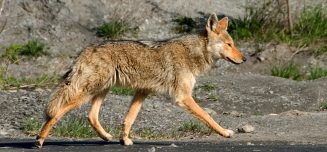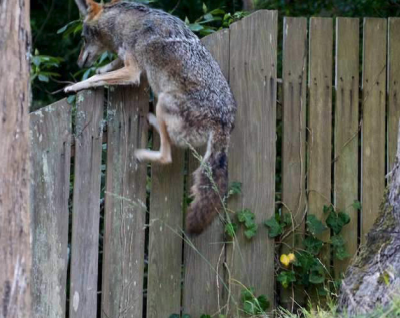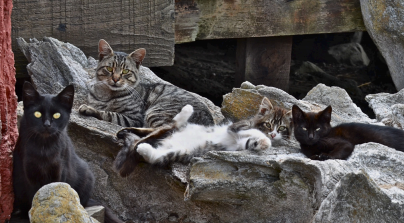Coyote Conflicts
 Coyotes generally avoid humans, even though our habitats overlap in San Diego County's urban and suburban areas. However, the presence of pet food, compost or trash can lure coyotes into yards and create the impression that these places are bountiful feeding areas. Without the attraction of food, their visits will be brief and rare. But a coyote who finds food in one yard may learn to search for food in others.
Coyotes generally avoid humans, even though our habitats overlap in San Diego County's urban and suburban areas. However, the presence of pet food, compost or trash can lure coyotes into yards and create the impression that these places are bountiful feeding areas. Without the attraction of food, their visits will be brief and rare. But a coyote who finds food in one yard may learn to search for food in others.
What Attracts Coyotes to Urban and Residential Areas?
Food
Although coyotes are a valuable part of our ecosystem, you should never intentionally feed them. Deliberately providing coyotes with food is a surefire way to get them accustomed to people and will ultimately lead to their demise. Here are some other general rules to follow:
- Avoid feeding pets outside. If you must, feed them only for a set time during the day (for no more than one hour) and remove the food bowl as soon as your pet has finished eating.
- In dry conditions, water can be as alluring as food, so remove water bowls set outside for pets and make watering cans unavailable.
- If you compost, use enclosed bins and never compost meat or fish scraps.
- Good housekeeping, such as regularly raking areas around bird feeders, can also help discourage coyote activity near residences.
- Remove fallen fruit from the ground.
- Keep trash in high-quality containers with tight-fitting lids. Only place the cans curbside the morning of collection. If you leave them out overnight, they are more likely to be tipped and broken into.
Shelter
Coyotes are secretive animals, and studies have shown they can live for a long time in close proximity to humans without ever being noticed. Such coyotes are coexisting with us peacefully, and should be left alone.
In the spring, when coyotes give birth and begin to raise litters, they concentrate their activities around dens or burrows in which their pups are sheltered. At these times, they may become highly defensive and territorial, and challenge any other coyote or dog that comes close to the pups. People walking their dogs in parks and wooded areas may run into these situations and even be challenged by parent coyotes to back off. Fights occur rarely and most often when dogs are off leash. It’s important to recognize such incidents for what they are: defense of space, not random attacks. If you encounter a coyote when walking your pet, do NOT run away. Instead, haze the coyote with the techniques described in our Coyote Hazing Guidelines flyer.
Pets
Pets may attract coyotes into certain neighborhoods. The best way to minimize risk to pets is not to leave them out unattended, particularly at night.
People who feed cats are often concerned coyotes might prey on the cats. Here are some general suggestions for keeping cats safer:
- Feed cats only during the day and at a set time-and pick up any leftovers immediately. Provide escape routes for cats. In treeless or open areas, erect “cat posts” (see below).
- Elevate feeding stations beyond a coyote’s reach. The size of the station/s can be customized to the size of the colony you feed, and the amount of food should be adjusted for the number of cats you feed. Avoid leftovers that attract other animals. Elevated feeding stations mean safer cats, no more messy, turned over bowls and great savings in cat food bills!
- In places where trees and other climbing opportunities are scarce, some people have reported success protecting cats from coyotes by giving the cats escape routes in the form of “cat posts.” These can be wooden posts (four inches by four inches or corner posts) that stand out of the ground at least ten to twelve feet and can be climbed by cats, but not by coyotes.
- Discourage coyotes seen on the property using the techniques described in our Coyote Hazing Guidelines. Making them feel uncomfortable will encourage them to stay out of the area.
Risks to Dogs

Dogs (especially small dogs) are also vulnerable to coyote confrontations. These incidents generally involve coyotes who are either accustomed to people (usually due to wildlife feeding), or coyotes who are protecting their territory and pups (usually during breeding season).
Although “attacks” on larger dogs are rarer, coyotes will sometimes go after a large dog when they feel that their territory is threatened. This generally occurs during the coyote breeding season, which takes place from January through March. During this time, it is especially important not to leave dogs outside unattended and to keep them on leashes when in public areas.
Protecting Your Yard
To further protect cats and dogs, fencing can be used to keep coyotes out of residential yards. Fences must be at least 6 feet tall, extend underground at least 12 inches or include an L-shaped mesh apron extending outward at least 12 inches and secured with landscaping staples. Devices such as the Coyote Roller (www.coyoteroller.com) “roll off’ coyotes that try to scramble over the fence and can enhance the effectiveness of a fence. Do-it-yourself options include adding PVC piping or chicken wire to the top of your fence to prevent coyotes from jumping over, and retrofitting a mesh apron to the bottom of the fence (extending over 12 inches out, secured with landscaping staples) to keep coyotes from digging under.


